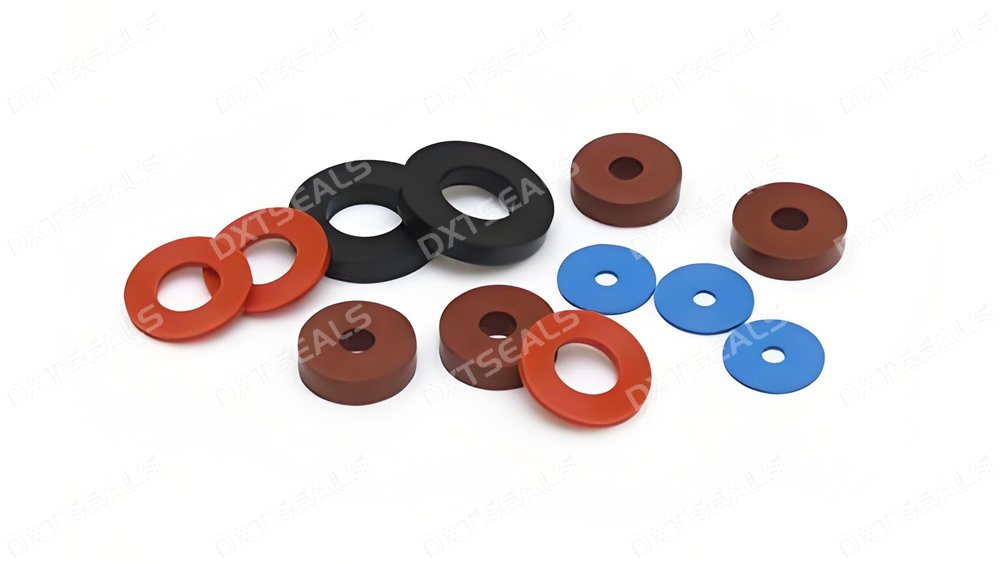
In industrial and commercial sealing applications, EPDM and silicone rubber are two of the most common elastomer choices—especially when the environment involves extreme temperatures or outdoor exposure. But which one performs better under these conditions?
In this article, DXTSEALS breaks down the strengths, weaknesses, and key differences between EPDM and silicone to help you choose the ideal material for your application.
🔍 Overview of EPDM and Silicone Rubber
| Property | EPDM | Silicone |
|---|---|---|
| Temperature Range | -50°C to +135°C (short-term to 150°C) | -60°C to +230°C (short-term to 250°C) |
| UV/Ozone Resistance | Excellent | Excellent |
| Weatherproofing | Very Good | Excellent |
| Chemical Resistance | Good (water, alcohols, some acids) | Moderate (not ideal for oils/fuels) |
| Flexibility at Low Temp | Moderate | Excellent |
| Cost | Lower | Higher |
| Typical Uses | Roofing, HVAC, automotive seals | Food-grade seals, medical, electronics |
☀️ Outdoor Durability: UV, Ozone, and Weather Resistance
Both EPDM and silicone offer outstanding UV and ozone resistance, making them excellent for outdoor environments. However:
-
EPDM is more widely used for general outdoor sealing in roofing, construction, and vehicles because of its lower cost and strong resistance to weathering and aging.
-
Silicone excels in extreme cold or high-altitude environments due to its exceptional flexibility and thermal stability, even at sub-zero temperatures.
✅ Conclusion:
For standard outdoor sealing, EPDM is cost-effective and durable. For harsh climate fluctuations, silicone has the edge.
🔥 High-Temperature Resistance
-
Silicone is the superior choice when dealing with sustained high temperatures, tolerating up to 230°C (446°F) or higher in short bursts.
-
EPDM performs well up to 135°C (275°F) continuously, with short-term exposure possible up to 150°C, but it will degrade faster beyond this range.
✅ Conclusion:
For heat-intensive environments such as engine compartments, ovens, or high-heat industrial machinery, silicone is the better option.
🛠 Mechanical & Chemical Considerations
-
EPDM has better resistance to water, steam, and some mild chemicals, making it ideal for HVAC, plumbing, and automotive cooling systems.
-
Silicone offers superior compression set resistance and remains flexible at very low temperatures, making it ideal for static seals and low-pressure gaskets.
However, silicone is not resistant to petroleum-based oils and fuels, whereas EPDM also performs poorly in oil environments. If oil resistance is needed, FKM (Viton®) is a better choice.
💰 Cost and Availability
-
EPDM is generally cheaper and more readily available for large-volume outdoor sealing needs.
-
Silicone is more expensive but justifiable for high-precision, extreme-temperature, or hygienic (medical/food) applications.
🧪 Typical Applications
| EPDM Applications | Silicone Applications |
|---|---|
| Window/door seals | Medical tubing |
| Roof membranes | Kitchen appliances |
| Radiator and heater hoses | Electronics insulation |
| Weatherstripping | High-temp gaskets |
🧭 Final Verdict: Which Should You Choose?
| Application Type | Recommended Material |
|---|---|
| General outdoor sealing | ✅ EPDM |
| Extreme heat exposure | ✅ Silicone |
| Cold flexibility needed | ✅ Silicone |
| Budget-sensitive projects | ✅ EPDM |
| Food/medical-grade seal | ✅ Silicone |
📌 Conclusion
Both EPDM and silicone have their strengths. For cost-effective, weather-resistant outdoor applications, EPDM is the go-to choice. For high-temperature, precision, or hygiene-critical environments, silicone delivers unmatched performance.
At DXTSEALS, we offer custom-molded EPDM and silicone products tailored to your application. Whether you need a gasket that survives the sun or one that resists heat and cold extremes, our engineers can help you make the right material choice.
📩 Need help deciding between EPDM and silicone? Contact DXTSEALS for technical support and material samples.
